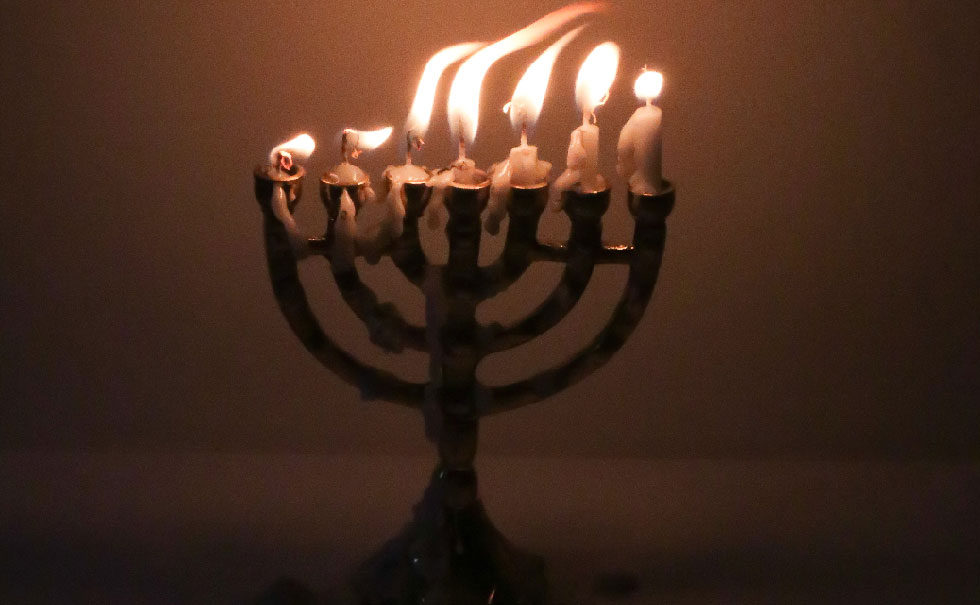Vayakhel
Last weeks Parsha was fraught with uncertainty and the terrible incident with the Golden Calf to the building of the Mishkan and its various implements,
Perhaps most notably the change from the Golden Calf, associated with various fertility cults and physicality to the golden Menorah – a symbol of light and enlightenment.
Also within our Parsha the command to create the Ark and its angelic inspired covering with two “Cherubs” (Cherubim: כְּרֻבִ֖ים) on top[1]:
וְעָשִׂ֛יתָ שְׁנַ֥יִם כְּרֻבִ֖ים זָהָ֑ב מִקְשָׁה֙ תַּעֲשֶׂ֣ה אֹתָ֔ם מִשְּׁנֵ֖י קְצ֥וֹת הַכַּפֹּֽרֶת׃
וַ֠עֲשֵׂ֠ה כְּר֨וּב אֶחָ֤ד מִקָּצָה֙ מִזֶּ֔ה וּכְרוּב־אֶחָ֥ד מִקָּצָ֖ה מִזֶּ֑ה מִן־הַכַּפֹּ֛רֶת תַּעֲשׂ֥וּ אֶת־הַכְּרֻבִ֖ים עַל־שְׁנֵ֥י קְצוֹתָֽיו׃
וְהָי֣וּ הַכְּרֻבִים֩ פֹּרְשֵׂ֨י כְנָפַ֜יִם לְמַ֗עְלָה סֹכְכִ֤ים בְּכַנְפֵיהֶם֙ עַל־הַכַּפֹּ֔רֶת וּפְנֵיהֶ֖ם אִ֣ישׁ אֶל־אָחִ֑יו אֶ֨ל־הַכַּפֹּ֔רֶת יִהְי֖וּ פְּנֵ֥י הַכְּרֻבִֽים׃
Make two cherubim of gold—make them of hammered work—at the two ends of the cover.
Make one cherub at one end and the other cherub at the other end; of one piece with the cover shall you make the cherubim at its two ends.
The cherubim shall have their wings spread out above, shielding the cover with their wings. They shall confront each other; the faces of the cherubim being turned toward the cover.
The Cherubim actually feature throughout the Torah and its literature, especially in Ezekiel’s vision of God’s Chariot[2]: it was according to tradition[3] the second lowest of the ten types of angels. The earliest mention of Cherubim in the Torah is[4] when Hashem placed the Cherubim with gleaming swords to guard the path to the Tree of Life – seemingly[5] one was male and one was female
Aside from the Midrashic information about Cherubim that are frequently quoted and explored, an essential question remains:
Why was the creation of the Golden Calf intrinsically problematic and the creation of the Cherubim not?
Firstly, the obvious issue of worship is not present: the Golden Calf is an idol, whereas the Cherubim are not – however the narrative of the Torah would seem to indicate that this would be an issue, the fact that images are used could be easily confused or misconstrued, the Talmud describes to us their symbolic meaning[6]:
אמר רב קטינא: בשעה שהיו ישראל עולין לרגל מגללין להם את הפרוכת, ומראין להם את הכרובים שהיו מעורים זה בזה, ואומרים להן: ראו חבתכם לפני המקום כחבת זכר ונקבה
Rav Katina said: “When the Israelites would come to the Temple for the holiday the curtain would be pulled back for them and they would see the cherubs intertwined with each other. [The priests] would say to them: “Behold, the love of you before God is like the love of man and woman.”
From the earliest times, before the advent of structured writing systems[7] such as Cuneiform the language of meaning was conveyed in symbolism, some of these symbols are so powerful that they have remained within the cultural framework of Humankind until this very day[8].
The Torah, whilst filled with figurative elements, metaphors, parables and other examples of non literal content, an overriding idea is repeated and clear[9]:
לֹֽ֣א־תַֽעֲשֶׂ֨ה־לְךָ֥֣ פֶ֣֙סֶל֙ ׀ וְכׇל־תְּמוּנָ֔֡ה אֲשֶׁ֤֣ר בַּשָּׁמַ֣֙יִם֙ ׀ מִמַּ֔֡עַל וַֽאֲשֶׁ֥ר֩ בָּאָ֖֨רֶץ מִתחַת וַאֲשֶׁ֥ר בַּמַּ֖֣יִם ׀ מִתַּ֥֣חַת לָאָֽ֗רֶץ׃
You shall not make for yourself a sculptured image, or any likeness of what is in the heavens above, or on the earth below, or in the waters under the earth.
Seemingly when the metaphorical becomes concretised into a form a worship the issues begin, we form God in the mirror of our cultural paradigms.
Our god then becomes a mirror of our own desires and inherent cultural archetypes rather than a symbol of transcendence: What is perhaps interesting is that the Scholars of Israel are split between two approaches to this subject of idolatry and leave us in a position of needing to reconcile and consider for ourselves our approach to this central Torah subject:
Firstly there are those who reject idolatry on the grounds that it is inherently foolish to do so:
The most well known proponent oft these ideas is the Rambam (Moses ben Maimon, commonly known as Maimonides 1138–1204) held[10] that all paganism and idolatry are totally in vain, and the Torah forbade them in order to prevent Israel being foolish, This is also the opinion of his supporters such as the Meiri[11] (Menachem ben Solomon Meiri 1249-1315).
Then we have, by far the majority opinion[12] that such things are very real and post a real present danger, in general they quote various ideas from the Tanach as well as the words of our Sages that sorcerers [13]and magicians had the power to influence events in the world.
We also find that our Sages related to the reality of demons[14] as real, in terms of their world view and that this understanding was an essential element in terms of their paradigm.
Various approaches have existed within this dichotomy of what we now call the rationalist and mystical approach to our Torah and both sides are interesting and have shaped Jewish practices in the communities that have favoured each approach.
Tor return to answer to our question, we must further ask: does the Torah specifically forbid the entire concept of creating items such as the Cherubim of the ark?[15]:
לֹ֥א תַעֲשׂ֖וּן אִתִּ֑י אֱלֹ֤הֵי כֶ֙סֶף֙ וֵאלֹהֵ֣י זָהָ֔ב לֹ֥א תַעֲשׂ֖וּ לָכֶֽם׃
With Me, therefore, you shall not make any gods of silver, nor shall you make for yourselves any gods of gold.
The Midrash explains[16]:
לא תעשו לכם שלא תאמר, הואיל ונתנה תורה רשות לעשות בבית המקדש, הריני עושה בבתי כנסיות ובבתי מדרשות – תלמוד לומר לא תעשו לכם. דבר אחר, לא תעשו לכם אלהי כסף, שלא תאמרו הרי אנו עושין בדרך שאחרים עושיס במדינות, תלמוד לומר לא תעשו לכם.
…[17]”You shall not make for yourselves”: Do not say: Since the Torah permitted this (the making of cherubs) in the Temple, I shall do the same in synagogues and in houses of study; it is, therefore, written “You shall not make for yourselves:”… “… gods of silver you shall not make for yourselves”: Do not say: We shall do for ourselves as others do in other countries. It is, therefore, written “You shall not make for yourselves.”
Seemingly the human need for symbols is ever present – However it is only permissible according to the Law of the Torah: in this one instance we are not “allowed” to create a graven image, we are commanded to do so – that is the central difference.
Even though the risk of confusion is great, the Torah nonetheless commands us to create the Cherubim at exactly the focal part of the Mishkan and what will later become the Temple in Jerusalem – although the Ark and Cherubim were absent from the 2nd temple:
The subject of the missing Ark is dealt with in the Mishnah[18] and the Talmud[19] provides many details on the various opinions: seemingly only the Ark built in the time of Moshe is a permissible[20].
All of us, so to speak choose daily between our Golden Calf and our Golden Menorah – we know how we desire things to be, and yet the mature soul knows that it is often not a reflection of reality: We live in age where spirituality for many has lost meaning: We are required to choose everyday between the focus on our material worth and our need to be a light unto ourselves and others – arguably this process begins by accepting that whatever is within us is as precious as gold, we have all fallen short at times and excelled at others, we can choose to focus on the good and get back up and do better rather than simply giving up and making excuses for our failings.
Shabbat Shalom!
Rabbi Jonathan Goldschmidt 2022 ©
[1] Shemot/Exodus 25:18-20
[2] Ezekiel: 1 & 10
[3] Mishneh Torah: Yesodei HaTorah 2:7
[4] Bereshit/Genesis: 3:24
[5] Rashi on Chronicles: 25-17-22
[6] Talmud Bavli: Yoma: 74a
[7] Some scholars suggest up to 8000 years before formulised writings – Human origins initiative: The Smithsonian’s National Museum of Natural History. National Museum of Natural History
[8] See Carl G. Yung: Man and his symbols (1964) – in particular his preliminary introduction.
[9] Exodus/Shemot: 20:4
[10] (Mishneh Torah Laws of Avodah Zara 11: 16; Moreh Nevuchim 3: 37).
[11] Most notably his commentary on Talmud Avodah Zara 54b
[12] Ramban (see his commentary on Devarim/Deuteronomy 18: 9), Rabbeinu Bahai, Sefer HaIkarim, Ran, Rivash, Abarbanel, Radbaz, Gra, Ramchal, and many others.
[13] Sanhedrin 67b
[14] Berachot 6a; Yevamot 122a, and other places
[15] Shemot/Exodus: 20:20
[16] Mekhilta d’Rabbi Yishmael (Ibid. 20)
[17] Shemot/Exodus 25:20
[18] Mishnah Shekalim (6,2), the Ark was hidden and not missed & Mishna Yoma (5, 2), the Ark was swept away (lost).
[19] Talmud Bavli: Yoma: 53b-54a
[20] Minchat Chinukh: Chapter 95




